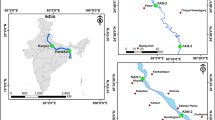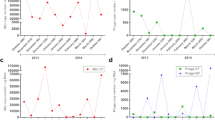Abstract
An increased incidence of cyanobacterial blooms, which are largely composed of toxigenic cyanobacteria from the Microcystis genus, leads to a disruption of aquatic ecosystems worldwide. Therefore, a better understanding of the impact of environmental parameters on the development and collapse of blooms is important. The objectives of the present study were as follows: (1) to investigate the presence and identity of Microcystis-specific cyanophages capable of cyanobacterial cell lysis in a lowland dam reservoir in Central Europe; (2) to investigate Microcystis sensitivity to phage infections with regard to toxic genotypes; and (3) to identify key abiotic parameters influencing phage infections during the summer seasons between 2009 and 2013. Sequencing analysis of selected g91 gene amplification products confirmed that the identified cyanophages belonged to the family Myoviridae (95 % homology). Cyanophages and Microcystis hosts, including toxic genotypes, were positively correlated in 4 of the 5 years analyzed (r = 0.67–0.82). The average percentage of infected Microcystis cells varied between 0.1 and 32 %, and no particular sensitivity of the phages to toxigenic genotypes was recorded. The highest number of cyanophages (>104 gene copy number per microliter) was observed in the period preceded by the following: an increase of the water retention time, growth of the water temperature, optimum nutrient concentrations, and the predomination of Microcystis bloom.


Similar content being viewed by others
References
Welker M, Brunke M, Preussel K, Lippert I, von Döhren H (2004) Diversity and distribution of Microcystis (cyanobacteria) oligopeptide chemotypes from natural communities studies by single-colony mass spectrometry. Microbiology 150:1785–1796. doi:10.1099/mic.0.26947-0
Šejnohová L, Maršálek B (2012) Microcystis. In: Whitton BA (ed) Ecology of cyanobacteria ii: their diversity in space and time. Springer Verlag GmbH, Heidelberg, pp 195–227
Paerl HW, Paul VJ (2012) Climate change: links to global expansion of harmful cyanobacteria. Water Res 46:1349–1363. doi:10.1016/j.watres.2011.08.002
Meissner S, Steinhauser D, Dittmann E (2015) Metabolomic analysis indicates a pivotal role of the hepatotoxin microcystin in high light adaptation of Microcystis. Environ Microbiol 17:1497–1509. doi:10.1111/1462-2920.12565
Merel S, Walker D, Chicana R, Snyder S, Baurès E, Thomas O (2013) State of knowledge and concerns on cyanobacterial blooms and cyanotoxins. Environ Int 59:303–327. doi:10.1016/j.envint.2013.06.013
Srivastava A, Ahn C, Asthana RK, Lee HG, Oh HM (2015) Status, alert system, and prediction of cyanobacterial bloom in South Korea. Biomed Res Int 2015:8. doi:10.1155/2015/584696
Sigee DC, Glenn R, Andrews MJ, Bellinger EG, Butler RD, Epton HAS, Hendry RD (1999) Biological control of cyanobacteria: principles and possibilities. Hydrobiologia 395(396):161–172. doi:10.1023/A:1017097502124
Wu L, Wu H, Chen L, Xie S, Zang H, Borriss R, Gao X (2014) Bacilysin from Bacillus amyloliquefaciens FZB42 has specific bactericidal activity against harmful algal bloom species. Environ Microbiol 80(24):7512–7520. doi:10.1128/AEM.02605-14
Gerphagnon M, MacArthur DJ, Latour D, Gachon CM, Van Ogtrop F, Gleason FH, Sime-Ngando T (2015) Microbial players involved in the decline of filamentous and colonial cyanobacterial blooms with a focus on fungal parasitism. Environ Microbiol 17(8):2573–2587. doi:10.1111/1462-2920.12860
Paerl HW, Otten TG (2013) Harmful cyanobacterial blooms: causes, consequences, and controls. Microb Ecol 65:995–1010. doi:10.1007/s00248-012-0159-y
Tucker S, Pollard P (2005) Identification of cyanophage Ma-LBP and infection of the cyanobacterium Microcystis aeruginosa from an Australian subtropical lake by the virus. Appl Environ Microbiol 71:629–635. doi:10.1128/AEM.71.2.629-635.2005
Yoshida M, Yoshida T, Kashima A, Takashima Y, Hosoda N, Nagasaki K, Hiroishi S, Prefectural F (2008) Ecological dynamics of the toxic bloom-forming Microcystis aeruginosa and its cyanophages in freshwater. Appl Environ Microbiol 74:3269–3273. doi:10.1128/AEM.02240-07
Kimura S, Yoshida T, Hosoda N, Honda T, Kuno S, Kamiji R, Hashimoto R, Sako Y (2012) Diurnal infection patterns and impact of Microcystis cyanophages in a Japanese pond. Appl Environ Microbiol 78:5805–5811. doi:10.1128/AEM.00571-12
Matteson AR, Loar SN, Bourbonniere RA, Wilhelm SW (2011) Molecular enumeration of an ecologically important cyanophage in a Laurentian Great Lake. Appl Environ Microbiol 77(19):6772–6779. doi:10.1128/AEM.05879-11
Zhong X, Ram AS, Colombet J, Jacquet S (2014) Variations in abundance, genome size, morphology, and functional role of the virioplankton in lakes Annecy and Bourget over a 1-Year Period. Microb Ecol 67:66–82. doi:10.1007/s00248-013-0320-2
Jassim S, Limoges RG (2013) Impact of external forces on cyanophage-host interactions in aquatic ecosystems. World J Microbiol Biotechnol 29:1751–1762. doi:10.1007/s11274-013-1358-5
Hendrix RW, Smith MC, Burns RN, Ford ME, Hatfull GF (1999) Evolutionary relationship among bacteriophages and prophages: all the worlds a phage. Proc Natl Acad Sci U S A 95(5):2192–2197. doi:10.1073/pnas.96.5.2192
Yoshida T, Nagasaki K, Takashima Y, Shirai Y, Tomaru Y, Takao Y, Sakamoto S, Hiroishi S, Ogata H (2008) Ma-LMM01 infecting toxic Microcystis aeruginosa illuminates diverse cyanophage genome strategies. J Bacteriol 190:1762–1772. doi:10.1128/JB.01534-07
Yoshida M, Yoshida T, Yoshida-Takashima Y, Kashima A, Hiroishi S (2010) Real-time PCR detection of host-mediated cyanophage gene transcripts during infection of a natural Microcystis aeruginosa population. Microbes Environ 25:211–215. doi:10.1264/jsme2.ME10117
Xia H, Li T, Deng F, Hu Z (2013) Freshwater cyanophages. Virol Sin 28:253–259. doi:10.1007/s12250-013-3370-1
Moisa I, Sotropa E, Velehorschi V (1981) Investigations on the presence of cyanophages in fresh and sea waters of Romania. Virol 32:127–132
Suttle CA, Chan AM (1993) Marine cyanophages infecting oceanic and coastal strains of Synechococcus: abundance, morphology, cross-infectivity and growth characteristics. Mar Ecol Prog Ser 92:99–109. doi:10.3354/meps092099
Wilson WH, Joint IR, Carr NG, Mann NH (1993) Isolation and molecular characterization of five marine cyanophages propagated on Synechococcus sp. strain WH7803. Appl Environ Microbiol 59:3736–43. doi: 0099-2240/93/113736-08$02.00/0
Lu J, Chen F, Hodson RE (2001) Distribution, isolation, host specificity, and diversity of cyanophages infecting marine Synechococcus spp. in river estuaries. Appl Environ Microbiol 67(7):3285–3290. doi:10.1128/AEM.67.7.3285-3290.2001
Wang K, Chen F (2008) Prevalence of highly host-specific cyanophages in the estuarine environment. Environ Microbiol 10(2):300–312. doi:10.1111/j.1462-2920.2007.01452.x
Takashima Y, Yoshida T, Yoshida M, Shirai Y, Tomaru Y, Takao Y, Hiroishi S, Nagasaki K (2007) Development and application of quantitative detection of cyanophages phylogenetically related to cyanophage Ma-LMM01 infecting Microcystis aeruginosa in freshwater. Microbes Environ 22:207–213. doi:10.1264/jsme2.22.207
Ou T, Li S, Liao X, Zhang Q (2013) Cultivation and characterization of the MaMV-DC cyanophage that infects bloom-forming cyanobacterium Microcystis aeruginosa. Virol Sin 28:266–271. doi:10.1007/s12250-013-3340-7
Li S, Ou T, Zhang Q (2013) Two virus-like particles that cause lytic infections in freshwater cyanobacteria. Virol Sin 28:303–305. doi:10.1007/s12250-013-3339-0
Watkins SC, Smith JR, Hayes PK, Watts JEM (2014) Characterisation of host growth after infection with a broad-range freshwater cyanopodophage. PLoS One 9:1–8. doi:10.1371/journal.pone.0087339
Liu X, Shi M, Kong S, Gao Y, An C (2007) Cyanophage Pf-WMP4, a T7-like phage infecting the freshwater cyanobacterium Phormidium foveolarum: complete genome sequence and DNA translocation. Virology 366:28–39. doi:10.1016/j.virol.2007.04.019
Chenard C, Chan AM, Vincent WF, Suttle CA (2015) Polar freshwater cyanophage S-EIV1 represents a new widespread evolutionary lineage of phages. ISME J 9(9):2046–2058. doi:10.1038/ismej.2015.24
Sulcius S, Simoliunas E, Staniulis J, Koreiviene J, Baltrusis P, Meskys R, Paskauskas R (2015) Characterization of a lytic cyanophage that infects the bloom-forming cyanobacterium Aphanizomenon flos-aquae. FEMS Microbiol Ecol 91(2):1–7. doi:10.1093/femsec/fiu012
Kimura S, Sako Y, Yoshida T (2013) Rapid Microcystis cyanophage gene diversification revealed by long and short-term genetic analyses of the tail sheath gene in a natural pond. Appl Environ Microbiol 79:2789–2795. doi:10.1128/AEM.03751-12
Nakamura G, Kimura S, Sako Y, Yoshida T (2014) Genetic diversity of Microcystis cyanophages in two different freshwater environments. Arch Microbiol 196:401–409. doi:10.1007/s00203-014-0980-4
Kimura-Sakai S, Sako Y, Yoshida T (2015) Development of a real-time PCR assay for the quantification of Ma-LMM01-type Microcystis cyanophages in a natural pond. Lett Appl Microbiol 60:400–408. doi:10.1111/lam.12387
Gągała I, Izydorczyk K, Jurczak T, Mankiewicz-Boczek J (2012) The key parameters and early warning methods to identify presence of toxigenic blooms dominated by Microcystis aeruginosa in the Jeziorsko reservoir (Central Poland). Fresenius Environ Bull 21:295–303
HACH (1991) Water analysis handbook. Method no. 10071 Hach Company, 1309
Golterman H, Clymo R, Ohstand M (1978) Methods for physical and chemical analysis of freshwater. Blackwell Scientific Publication, Oxford, 213p
Mankiewicz-Boczek J, Izydorczyk K, Romanowska-Duda Z, Jurczak T, Stefaniak K, Kokociński M (2006) Detection and monitoring toxigenicity of cyanobacteria by application of molecular methods. Environ Toxicol 21:380–387. doi:10.1002/tox
Giovannoni SJ, DeLong EF, Schmidt TM, Pace NR (1990) Tangential flow filtration and preliminary phylogenetic analysis of marine picoplankton. Appl Environ Microbiol 56:2572–75. doi: 0099-2240/90/082572-04$02.00/0
Ha JH, Hidaka T, Tsuno H (2009) Quantification of toxic Microcystis and evaluation of its dominance ratio in blooms using real-time PCR. Environ Sci Technol 43:812–818. doi:10.1021/es801265f
Neilan BA, Jacobs D, Del Dot T, Blackall LL, Hawkins PR, Cox PT, Goodman AE (1997) rRNA sequences and evolutionary relationships among toxic and nontoxic cyanobacteria of the genus Microcystis. Int J Syst Bacteriol 47:693–7. doi: 0020-7713/97/$04.00 + 0
Gągała I, Izydorczyk K, Jurczak T, Pawełczyk J, Dziadek J, Wojtal-Frankiewicz A, Jóźwik A, Jaskulska A, Mankiewicz-Boczek J (2014) Role of environmental factors and toxic genotypes in the regulation of microcystins-producing cyanobacterial blooms. Microb Ecol 67(2):465–479. doi:10.1007/s00248-013-0303-3
Yoshida T, Takashima Y, Tomaru Y, Shirai Y, Takao Y, Hiroishi S, Nagasaki K (2006) Isolation and characterization of a cyanophage infecting the toxic cyanobacterium Microcystis aeruginosa. Appl Environ Microbiol 72:1239–1247. doi:10.1128/AEM.72.2.1239
Boutte C, Mankiewicz-Boczek J, Komarkova J, Grubisic S, Izydorczyk K, Wautelet F, Jurczak T, Zalewski M, Wilmotte A (2008) Diversity of planktonic cyanobacteria and microcystin occurrence in Polish water bodies investigated using a polyphasic approach. Aquat Microb Ecol 51(3):223–236. doi:10.3354/ame01194
Gągała I, Izydorczyk K, Skowron A, Kamecka-Plaskota D, Stefaniak K, Kokociński M, Mankiewicz-Boczek J (2010) Appearance of toxigenic cyanobacteria in two Polish lakes dominated by Microcystis aeruginosa and Planktothrix agardhii and environmental factors influence. Ecohydrol Hydrobiol 10(1):25–34. doi:10.2478/v10104-009-0045-5
Zalewski M, Naiman RJ (1985) The regulation of riverine fish communities by a continuum of abiotic-biotic factors. Habitat Modif Freshw Fish. pp. 3–9. In: Alabaster JS (ed.), Habitat Modification and Freshwater Fisheries: Proceedings of a Symposium of the European Inland Fisheries Advisory Commission Butterworths, London
Zhang Z, Schwartz S, Wagner L, Miller W (2000) A greedy algorithm for aligning DNA sequences. J Comput Biol 7(1-2):203–214. doi:10.1089/10665270050081478
Acknowledgments
This research was funded by the National Science Centre (PL), project no. UMO-2013/11/N/NZ8/00607 “Ecological dynamics of cyanophages and their host in Polish water bodies” and partially by no. UMO-2012/07/N/NZ8/00599 “Assessment of the interaction between hepatotoxic cyanobacterium Microcystis aeruginosa and pathogenic bacteria of the genus Aeromonas.” The authors would like to acknowledge the European Cooperation in Science and Technology, COST Action ES 1105 “CYANOCOST - Cyanobacterial blooms and toxins in water resources: Occurrence, impacts and management” for adding value to this study through networking and knowledge sharing with European experts and researchers in the field”. The Sulejów Reservoir is a part of the Polish National Long-Term Ecosystem Research Network and the European LTER site.
Conflict of Interest
The authors declare that they have no competing interests.
Author information
Authors and Affiliations
Corresponding author
Electronic Supplementary Material
Below is the link to the electronic supplementary material.
Supplementary material 1
Detection of cyanobacteria from the genus Microcystis (fragment of 16S rRNA gene), its toxic genotypes (fragment of mcyA gene) and cyanophages specific for Microcystis (fragment of g91 gene) in samples taken from Sulejów Reservoir, station Tresta, in following seasons 2009-2013. M – DNA marker; C – negative control – MiliQ water
Rights and permissions
About this article
Cite this article
Mankiewicz-Boczek, J., Jaskulska, A., Pawełczyk, J. et al. Cyanophages Infection of Microcystis Bloom in Lowland Dam Reservoir of Sulejów, Poland. Microb Ecol 71, 315–325 (2016). https://doi.org/10.1007/s00248-015-0677-5
Received:
Accepted:
Published:
Issue Date:
DOI: https://doi.org/10.1007/s00248-015-0677-5




